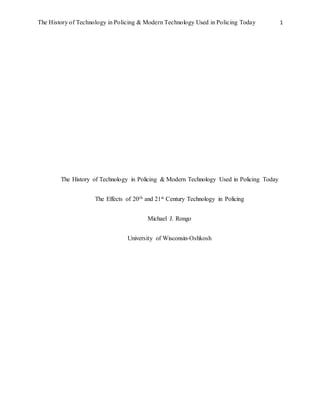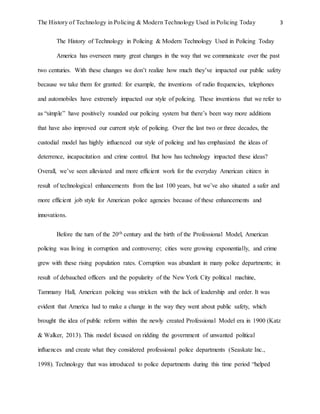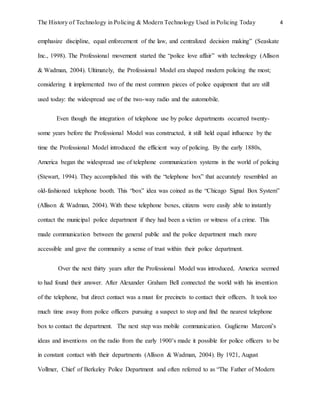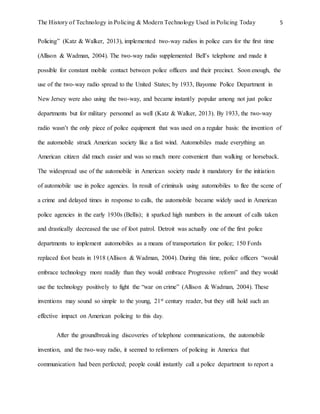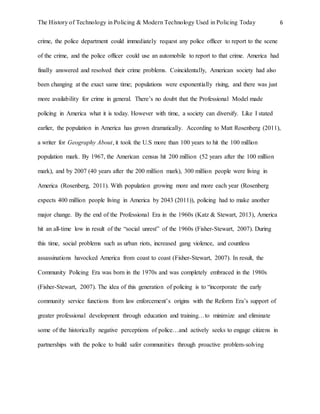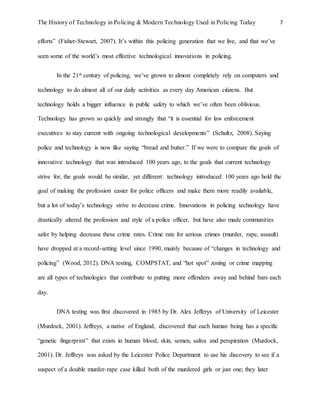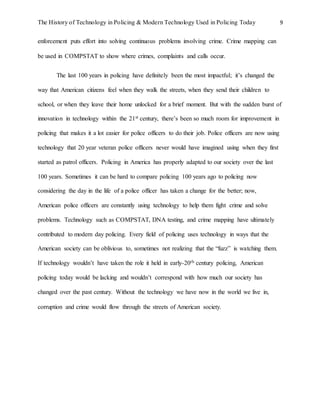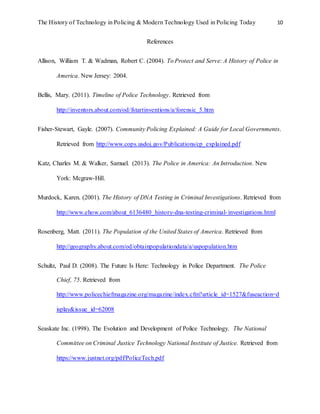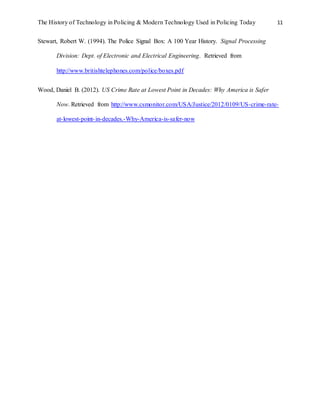CJ 288 paper
- 1. The History of Technology in Policing & Modern Technology Used in Policing Today 1 The History of Technology in Policing & Modern Technology Used in Policing Today The Effects of 20th and 21st Century Technology in Policing Michael J. Rongo University of Wisconsin-Oshkosh
- 2. The History of Technology in Policing & Modern Technology Used in Policing Today 2 Abstract This paper explores the research and history of technology used in policing. It mainly focuses on the groundbreaking technological discoveries that were invented from the end of the 19th century to the middle of the 20th. It also covers technologies that are used today in American policing. The relationship between our changing society and the change in policing over the last 100 years is presented within this research topic.
- 3. The History of Technology in Policing & Modern Technology Used in Policing Today 3 The History of Technology in Policing & Modern Technology Used in Policing Today America has overseen many great changes in the way that we communicate over the past two centuries. With these changes we donÔÇÖt realize how much theyÔÇÖve impacted our public safety because we take them for granted: for example, the inventions of radio frequencies, telephones and automobiles have extremely impacted our style of policing. These inventions that we refer to as ÔÇ£simpleÔÇØ have positively rounded our policing system but thereÔÇÖs been way more additions that have also improved our current style of policing. Over the last two or three decades, the custodial model has highly influenced our style of policing and has emphasized the ideas of deterrence, incapacitation and crime control. But how has technology impacted these ideas? Overall, weÔÇÖve seen alleviated and more efficient work for the everyday American citizen in result of technological enhancements from the last 100 years, but weÔÇÖve also situated a safer and more efficient job style for American police agencies because of these enhancements and innovations. Before the turn of the 20th century and the birth of the Professional Model, American policing was living in corruption and controversy; cities were growing exponentially, and crime grew with these rising population rates. Corruption was abundant in many police departments; in result of debauched officers and the popularity of the New York City political machine, Tammany Hall, American policing was stricken with the lack of leadership and order. It was evident that America had to make a change in the way they went about public safety, which brought the idea of public reform within the newly created Professional Model era in 1900 (Katz & Walker, 2013). This model focused on ridding the government of unwanted political influences and create what they considered professional police departments (Seaskate Inc., 1998). Technology that was introduced to police departments during this time period ÔÇ£helped
- 4. The History of Technology in Policing & Modern Technology Used in Policing Today 4 emphasize discipline, equal enforcement of the law, and centralized decision makingÔÇØ (Seaskate Inc., 1998). The Professional movement started the ÔÇ£police love affairÔÇØ with technology (Allison & Wadman, 2004). Ultimately, the Professional Model era shaped modern policing the most; considering it implemented two of the most common pieces of police equipment that are still used today: the widespread use of the two-way radio and the automobile. Even though the integration of telephone use by police departments occurred twenty- some years before the Professional Model was constructed, it still held equal influence by the time the Professional Model introduced the efficient way of policing. By the early 1880s, America began the widespread use of telephone communication systems in the world of policing (Stewart, 1994). They accomplished this with the ÔÇ£telephone boxÔÇØ that accurately resembled an old-fashioned telephone booth. This ÔÇ£boxÔÇØ idea was coined as the ÔÇ£Chicago Signal Box SystemÔÇØ (Allison & Wadman, 2004). With these telephone boxes, citizens were easily able to instantly contact the municipal police department if they had been a victim or witness of a crime. This made communication between the general public and the police department much more accessible and gave the community a sense of trust within their police department. Over the next thirty years after the Professional Model was introduced, America seemed to had found their answer. After Alexander Graham Bell connected the world with his invention of the telephone, but direct contact was a must for precincts to contact their officers. It took too much time away from police officers pursuing a suspect to stop and find the nearest telephone box to contact the department. The next step was mobile communication. Gugliemo MarconiÔÇÖs ideas and inventions on the radio from the early 1900ÔÇÖs made it possible for police officers to be in constant contact with their departments (Allison & Wadman, 2004). By 1921, August Vollmer, Chief of Berkeley Police Department and often referred to as ÔÇ£The Father of Modern
- 5. The History of Technology in Policing & Modern Technology Used in Policing Today 5 PolicingÔÇØ (Katz & Walker, 2013), implemented two-way radios in police cars for the first time (Allison & Wadman, 2004). The two-way radio supplemented BellÔÇÖs telephone and made it possible for constant mobile contact between police officers and their precinct. Soon enough, the use of the two-way radio spread to the United States; by 1933, Bayonne Police Department in New Jersey were also using the two-way, and became instantly popular among not just police departments but for military personnel as well (Katz & Walker, 2013). By 1933, the two-way radio wasnÔÇÖt the only piece of police equipment that was used on a regular basis: the invention of the automobile struck American society like a fast wind. Automobiles made everything an American citizen did much easier and was so much more convenient than walking or horseback. The widespread use of the automobile in American society made it mandatory for the initiation of automobile use in police agencies. In result of criminals using automobiles to flee the scene of a crime and delayed times in response to calls, the automobile became widely used in American police agencies in the early 1930s (Bellis); it sparked high numbers in the amount of calls taken and drastically decreased the use of foot patrol. Detroit was actually one of the first police departments to implement automobiles as a means of transportation for police; 150 Fords replaced foot beats in 1918 (Allison & Wadman, 2004). During this time, police officers ÔÇ£would embrace technology more readily than they would embrace Progressive reformÔÇØ and they would use the technology positively to fight the ÔÇ£war on crimeÔÇØ (Allison & Wadman, 2004). These inventions may sound so simple to the young, 21st century reader, but they still hold such an effective impact on American policing to this day. After the groundbreaking discoveries of telephone communications, the automobile invention, and the two-way radio, it seemed to reformers of policing in America that communication had been perfected; people could instantly call a police department to report a
- 6. The History of Technology in Policing & Modern Technology Used in Policing Today 6 crime, the police department could immediately request any police officer to report to the scene of the crime, and the police officer could use an automobile to report to that crime. America had finally answered and resolved their crime problems. Coincidentally, American society had also been changing at the exact same time; populations were exponentially rising, and there was just more availability for crime in general. Theres no doubt that the Professional Model made policing in America what it is today. However with time, a society can diversify. Like I stated earlier, the population in America has grown dramatically. According to Matt Rosenberg (2011), a writer for Geography About, it took the U.S more than 100 years to hit the 100 million population mark. By 1967, the American census hit 200 million (52 years after the 100 million mark), and by 2007 (40 years after the 200 million mark), 300 million people were living in America (Rosenberg, 2011). With population growing more and more each year (Rosenberg expects 400 million people living in America by 2043 (2011)), policing had to make another major change. By the end of the Professional Era in the 1960s (Katz & Stewart, 2013), America hit an all-time low in result of the social unrest of the 1960s (Fisher-Stewart, 2007). During this time, social problems such as urban riots, increased gang violence, and countless assassinations havocked America from coast to coast (Fisher-Stewart, 2007). In result, the Community Policing Era was born in the 1970s and was completely embraced in the 1980s (Fisher-Stewart, 2007). The idea of this generation of policing is to incorporate the early community service functions from law enforcements origins with the Reform Eras support of greater professional development through education and trainingto minimize and eliminate some of the historically negative perceptions of policeand actively seeks to engage citizens in partnerships with the police to build safer communities through proactive problem-solving
- 7. The History of Technology in Policing & Modern Technology Used in Policing Today 7 effortsÔÇØ (Fisher-Stewart, 2007). ItÔÇÖs within this policing generation that we live, and that weÔÇÖve seen some of the worldÔÇÖs most effective technological innovations in policing. In the 21st century of policing, weÔÇÖve grown to almost completely rely on computers and technology to do almost all of our daily activities as every day American citizens. But technology holds a bigger influence in public safety to which weÔÇÖve often been oblivious. Technology has grown so quickly and strongly that ÔÇ£it is essential for law enforcement executives to stay current with ongoing technological developmentsÔÇØ (Schultz, 2008). Saying police and technology is now like saying ÔÇ£bread and butter.ÔÇØ If we were to compare the goals of innovative technology that was introduced 100 years ago, to the goals that current technology strive for, the goals would be similar, yet different: technology introduced 100 years ago hold the goal of making the profession easier for police officers and make them more readily available, but a lot of todayÔÇÖs technology strive to decrease crime. Innovations in policing technology have drastically altered the profession and style of a police officer, but have also made communities safer by helping decrease these crime rates. Crime rate for serious crimes (murder, rape, assault) have dropped at a record-setting level since 1990, mainly because of ÔÇ£changes in technology and policingÔÇØ (Wood, 2012). DNA testing, COMPSTAT, and ÔÇ£hot spotÔÇØ zoning or crime mapping are all types of technologies that contribute to putting more offenders away and behind bars each day. DNA testing was first discovered in 1985 by Dr. Alex Jefferys of University of Leicester (Murdock, 2001). Jeffreys, a native of England, discovered that each human being has a specific ÔÇ£genetic fingerprintÔÇØ that exists in human blood, skin, semen, saliva and perspiration (Murdock, 2001). Dr. Jeffreys was asked by the Leicester Police Department to use his discovery to see if a suspect of a double murder-rape case killed both of the murdered girls or just one; they later
- 8. The History of Technology in Policing & Modern Technology Used in Policing Today 8 found that the man only killed one of them and matched the other DNA sample to arrest the other murderer (Murdock, 2001). DNA testing provides exact matches for crime scene investigators and allows forensic crimes to be solved by a quicker manner. DNA testing has been such a breakthrough for forensic studies; not only does it help catch the criminal, it greatly increases the chance of catching the actual criminal, and allows police officers and forensic analysts to save time and contribute that saved to solving and fighting more crime. Another technology, COMPSTAT (stands for ÔÇ£compare statisticsÔÇØ (Katz & Walker, 2013)), allows police departments to centralize their crime fighting in certain areas. COMPSTAT is a computer program that, Katz and Walker report, ÔÇ£is used as an organizational tool to achieve crime control through accountabilityÔÇØ (2013). The program continuously collects data from arrests, calls and complaints and organizes trends. It allows officers to make conclusions on trends and use ideas such as SARA (Scan, Analyze, Response and Assessment) to create solutions for ongoing problems in the community. COMPSTAT is a perfect example on why technology has played such a large part in our public safety. After first being introduced in 1994 in New York City, people have claimed that COMPSTAT has accounted for the dramatic drop in crime in New York City in the mid 1990ÔÇÖs (Katz & Walker, 2013). Katz and Walker report that COMPSTAT contributed to the 66% decrease in homicides in New York City (2013). Overall, COMPSTAT genuinely contributes to overall police performance and allows officers to brainstorm of new ideas to help decrease crime and disorder in communities. Crime mapping (or ÔÇ£hot spotÔÇØ zoning) goes hand-in-hand with COMPSTAT. Crime mapping can be a solution derived from analyzing COMPSTAT data, where departments will put emphasis on certain areas of the community where crime tends to occur most. They will enforce their patrol officers to centralize their focus on such areas to create a better environment and show that the local
- 9. The History of Technology in Policing & Modern Technology Used in Policing Today 9 enforcement puts effort into solving continuous problems involving crime. Crime mapping can be used in COMPSTAT to show where crimes, complaints and calls occur. The last 100 years in policing have definitely been the most impactful; itÔÇÖs changed the way that American citizens feel when they walk the streets, when they send their children to school, or when they leave their home unlocked for a brief moment. But with the sudden burst of innovation in technology within the 21st century, thereÔÇÖs been so much room for improvement in policing that makes it a lot easier for police officers to do their job. Police officers are now using technology that 20 year veteran police officers never would have imagined using when they first started as patrol officers. Policing in America has properly adapted to our society over the last 100 years. Sometimes it can be hard to compare policing 100 years ago to policing now considering the day in the life of a police officer has taken a change for the better; now, American police officers are constantly using technology to help them fight crime and solve problems. Technology such as COMPSTAT, DNA testing, and crime mapping have ultimately contributed to modern day policing. Every field of policing uses technology in ways that the American society can be oblivious to, sometimes not realizing that the ÔÇ£fuzzÔÇØ is watching them. If technology wouldnÔÇÖt have taken the role it held in early-20th century policing, American policing today would be lacking and wouldnÔÇÖt correspond with how much our society has changed over the past century. Without the technology we have now in the world we live in, corruption and crime would flow through the streets of American society.
- 10. The History of Technology in Policing & Modern Technology Used in Policing Today 10 References Allison, William T. & Wadman, Robert C. (2004). To Protect and Serve: A History of Police in America. New Jersey: 2004. Bellis, Mary. (2011). Timeline of Police Technology. Retrieved from http://inventors.about.com/od/fstartinventions/a/forensic_5.htm Fisher-Stewart, Gayle. (2007). Community Policing Explained: A Guide for Local Governments. Retrieved from http://www.cops.usdoj.gov/Publications/cp_explained.pdf Katz, Charles M. & Walker, Samuel. (2013). The Police in America: An Introduction. New York: Mcgraw-Hill. Murdock, Karen. (2001). The History of DNA Testing in Criminal Investigations. Retrieved from http://www.ehow.com/about_6136480_history-dna-testing-criminal-investigations.html Rosenberg, Matt. (2011). The Population of the United States of America. Retrieved from http://geography.about.com/od/obtainpopulationdata/a/uspopulation.htm Schultz, Paul D. (2008). The Future Is Here: Technology in Police Department. The Police Chief, 75. Retrieved from http://www.policechiefmagazine.org/magazine/index.cfm?article_id=1527&fuseaction=d isplay&issue_id=62008 Seaskate Inc. (1998). The Evolution and Development of Police Technology. The National Committee on Criminal Justice Technology National Institute of Justice. Retrieved from https://www.justnet.org/pdf/PoliceTech.pdf
- 11. The History of Technology in Policing & Modern Technology Used in Policing Today 11 Stewart, Robert W. (1994). The Police Signal Box: A 100 Year History. Signal Processing Division: Dept. of Electronic and Electrical Engineering. Retrieved from http://www.britishtelephones.com/police/boxes.pdf Wood, Daniel B. (2012). US Crime Rate at Lowest Point in Decades: Why America is Safer Now. Retrieved from http://www.csmonitor.com/USA/Justice/2012/0109/US-crime-rate- at-lowest-point-in-decades.-Why-America-is-safer-now
